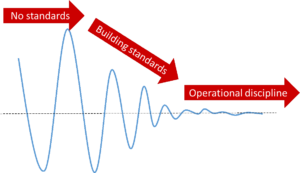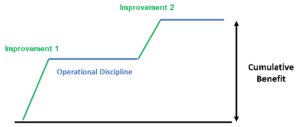Discipline and Operational Excellence

Discipline and Operational Excellence
Author : NICK BAILEY
Operational Excellence
Operational Excellence as an umbrella term is the coordinated application of a whole suite of tools and techniques to improve the performance (TPM, CI, Kaizen, Lean, Six sigma, Agile)
Regardless of the type of operation you are responsible for excellence is always the goal. Excellence can be thought of in many ways
- Better than the competition
- Beating our internal targets
- Perfection
Perfection can be described in different ways based on the type of business:
- Lowest possible cost (Zero loss, zero waste, zero downtime)
- 100% on time in full service
- Zero customer complaints
Wherever you are in your pursuit of perfection Operational Discipline will be a critical ingredient in your recipe for success.
What is Operational Discipline?
Operational Discipline can be defined as a constructive mindset and behavioral approach essential for achieving manufacturing excellence. This concept is not punitive or focused on sanctions; instead, it fosters a positive and proactive approach to optimizing operational processes. It emphasizes proactive and conscientious decision-making and actions within an operational context, emphasizing the cultivation of a strong foundation for operational excellence.
Operational discipline is a mindset, a way of thinking about a situation and then behaving in a manner that is a foundation for operational excellence.
Operational Discipline is about consistency and rigor in all aspects of a business
There is a famous quote from one of the founders of the Toyota Production System, Taiichi Ohno, which says “there can be no improvement without standards”. A useful qualification to that quote could be ‘the standard must be followed with discipline (consistency and rigor)’.
Consistency means – reliability, regularity, steadiness – if something is an important contributor to the success of our business then it must be looked after and reinforced.
Operational rigor means adhering to a high level of thoroughness, attention to detail, and strictness - if something is an important contributor to the success of our business then it must be respected absolutely.ng is an important contributor to the success of our business then it must be respected absolutely.
If today’s standard is the foundation for tomorrows improvement, we need to have solid standards.
- Do the right task
- Do it the right way
- Do it at the right time
- Do it every time

If we don’t have the operational discipline to take care of our standards, we will not be able to realize the efforts of our improvements. For every two steps we take forward we could easily take one step backwards.
Without Operational discipline – no standards – no sustaining
With Operational Discipline – each improvement builds on the last
Improving a manufacturing quality KPI is easier when a process is in control – when there is operational discipline around known standards. In chaotic situations the root cause of failure is more difficult to identify because of the ‘system noise’. The effect of improvement efforts can be difficult to relate into performance because there are so many moving parts.
Consider a process where opportunities exist to improve the quality of the ‘result’. The process has many points of potential variation. Some common real-life examples are:
- A large facility has multiple ‘identical’ pieces of equipment making the same product but close inspection/analysis reveals that the machines are all subtly different.
- When one team finishes work and another team takes over numerous small adjustments are performed to ‘get things set up properly’. The same process in reverse happens when the first team come back to work.
- The ERP system can’t handle certain orders using the normal fields/drop down boxes for customer service associates so they have to use the ‘notes’ field but the information is free text.
Operational Discipline around standards – what type of standards are there, how do we discover them, how do we sustain them, and how do we improve them?
Discovering standards – The simplest approach is to consider the 4M’s:
- Machine – reliability and predictability/precision – disciplined maintenance (maintaining standards), clearances, tolerances etc. Identifying and maintaining machine standards. Autonomous Maintenance, Planned Preventative Maintenance pillars in a TPM approach.
- huMan – consistent knowledge and skill to maintain a process, carry out a task, lead a team. Providing the most efficient and effective training standard reduces variation.
- Method – standardized, optimized, and defined method/tools to perform a task. The best method will be discovered and evolve through the use of Continuous Improvement/Kaizen activities.
- Material – Product development, engineers, purchasing, and quality assurance are typically familiar with standards – in the form of material and product specifications.
Sustaining Standards
Sustaining standards is the essence of Operational Discipline as laid out in this article. Examples of commonly understood standards are described above, some more advanced concepts are described below.
Sustaining standards requires clear ownership. Ownership can be documented and given but needs to be understood and taken. Educating the organization on the broader concept of standards and involving them in developing the standards will facilitate associates taking ownership. Leaders have to provide the structure, framework, and the time to allow associates to take care of their standards.
Leaders also have to play their part in sustaining standards. If it is a critical factor for business success that associates feel ownership for their standards then it follows that it is critical for leaders to lead by example and reinforce the sustaining of standards as part of their own routine. Engaging with their team and the supporting hierarchy to understand how standards are being developed, cared for and improved. Having this layered auditing approach ensures alignment and an overlapping structure of back up knowledge/experience.
Having an Operational Excellence or Performance System builds the framework to discover, sustain, and improve standards in a consistent and rigorous manner.
Improving Standards
Improving standards is the aim of Continuous Improvement activities. Each improvement activity we run should develop new standards or improve existing ones to generate better performance from the process we are working on.
Performance Solution by Milliken recently worked with a client who had been manufacturing the same product for over 30 years. The market was expanding and new competitors were entering. The product has very high quality requirements due to the nature of its use and is highly regulated.
The opportunity we saw was the quality yield rate. After 30 years of experience the site still had huge potential to improve. A combination of
- workshop activities to discover and formalize existing standards involving production, maintenance and subject matter experts
- clearly defined defect reduction projects (DMAIC) to improve standards and uncover new ones
- building standard work, layered audits across all relevant functions to sustain the optimized standards
- led to a reduction quality yield loss of 75%.
Expanding on the idea of operational discipline we should also consider a broader scope
Leadership operational discipline
Leader standard work – creates expectations, provides cadence and consistency. The subjects that leaders devote time to demonstrates what is important. Standard work including layered auditing of standards displays and supports operational discipline. Leadership must reinforce operational discipline not only in what they say but also in what they do. Standard work is a tool most often associated with Lean Manufacturing but is not exclusive to that approach and should be considered as an important ingredient in establishing manufacturing excellence across different approaches.
Leadership behaviors – have to be consistent/disciplined. Not about being robots but is about consistently providing direction, involving everyone, expecting the best and recognizing contribution. Every day.
Process Discipline
Operational Excellence is a series of connected processes/systems.
Processes are effective when they are used in a disciplined way – for example
- A strategy deployment process sets the priorities and direction for an organization; it must be kept updated and routinely communicated to align and engage the organization.
- Continuous Improvement – a reliable process to make improvements. If we have a proven process/approach to get better, for example DMAIC, then it makes sense to practice using this process. Not only to deliver improvements in a predictable manner but to build upon our experience, develop expertise, and improve our capacity to improve.
Organizational discipline
The optimum performance of an organization relies on the application of operational discipline across functions, departments, and hierarchies because of inter-dependencies.
Operational discipline can only be effective when adopted by the whole organization. Quality manufacturing relies on each of the types of standards we have discussed above being managed by the appropriate part of the organization to strive for zero defects.
Organizational discipline relies on a framework. Building a management system that visualizes the roles and responsibilities for standards is the role of a pillar in the operational excellence system that Performance Solutions by Milliken has developed based on its own manufacturing experience. A Daily Management System is a fundamental part of the routine of each vertical tier of an organization and each horizontal function. The establishment of review and response meetings brings together the functions and departments. It’s all about the right people looking at the right topics on the right frequency in a routine and rigorous way.
Summary
Operational Discipline is a mindset, a way of thinking, but it can be realized in a number of very concrete and tangible ways. It doesn’t just exist in people head’s, it can be brought to life in every facet of an organization.
As is often the case establishing Operational Discipline requires leadership commitment; a robust structure; associate engagement and a change agent to teach, coach and mentor.
It is impossible for any organization to aim for perfection without Operational Discipline and it is a daunting undertaking to discover, sustain and improve your ‘standards’.
There are proven and well documented approaches to systematically change an organization’s view of and commitment to Operational Discipline. It is not purely a ‘mechanical process’, yes there are well defined steps but it also requires practical experience to help teams make a cultural shift where discipline is a virtue to be celebrated not a punishment to be feared.
The operational excellence consulting team at Performance Solutions by Milliken has the knowledge and experience to act as a change agent, support leaders and their teams to become discipline experts. Contact us today.”

